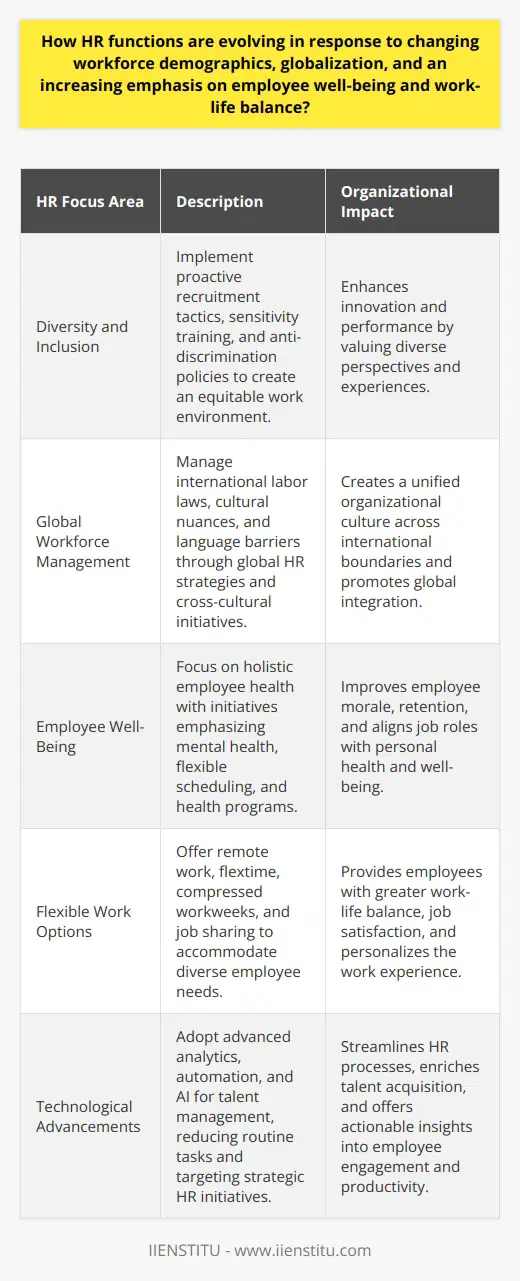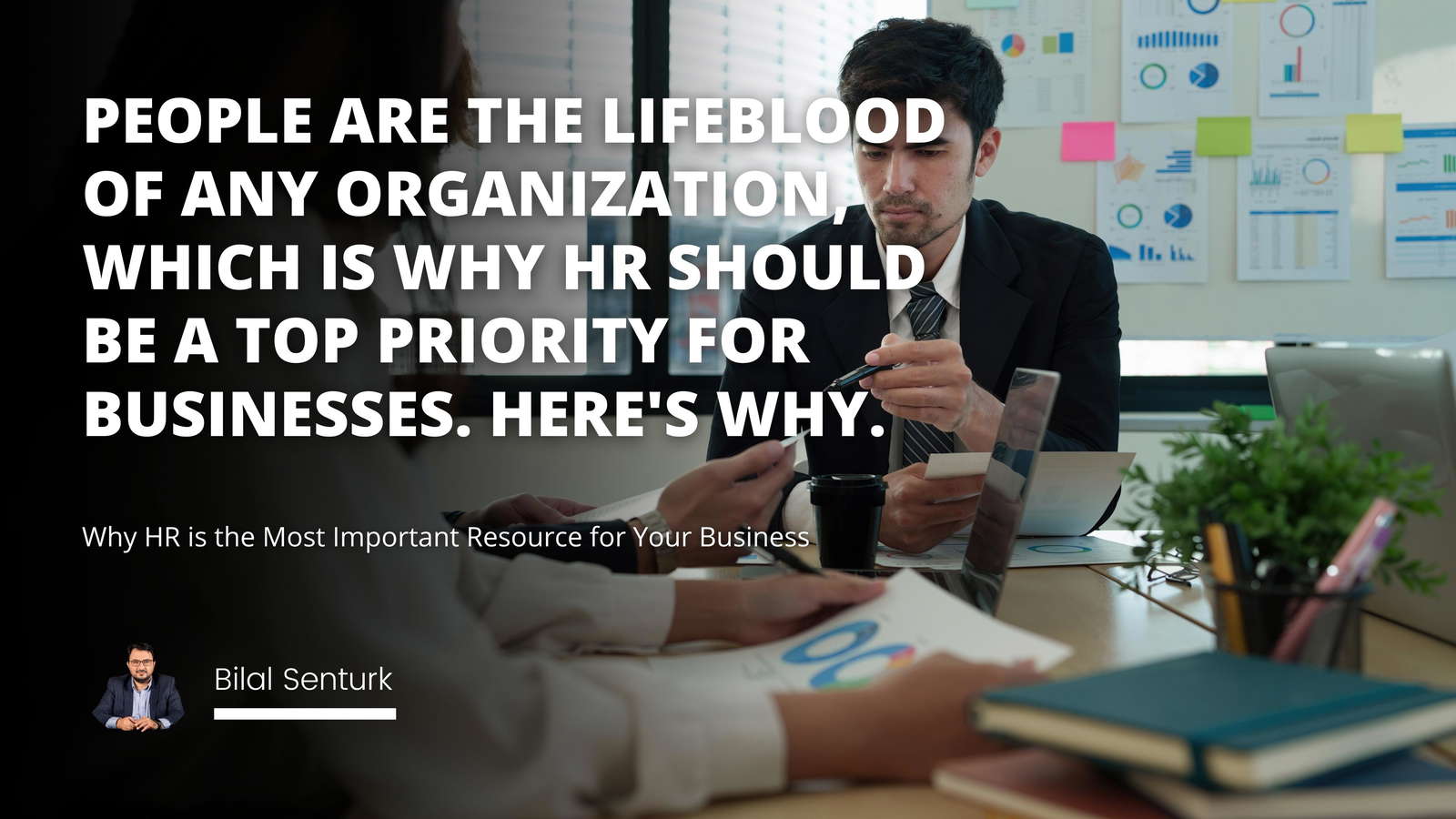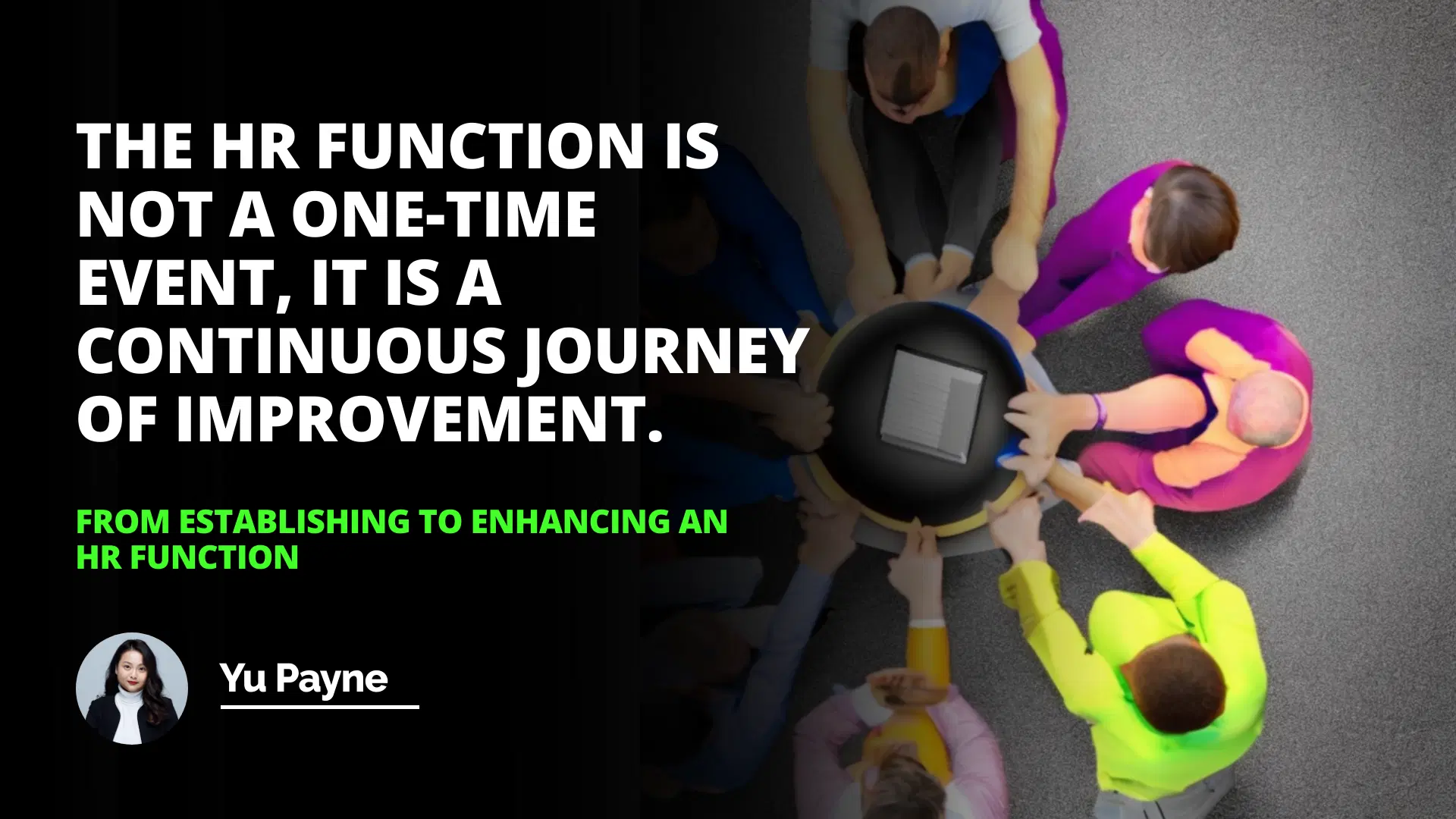
Establishing an HR Function
The Benefits of Professionalizing HR
Strategies for Enhancing an HR Function
Businesses of all sizes rely on an effective Human Resources (HR) function to ensure the success and well-being of their organizations. HR is responsible for everything from recruiting and retaining top talent to developing and administering compensation plans and benefits. Unfortunately, creating an HR function within an organization can be lengthy and complex. Still, once established, it can be further improved by leveraging various strategies for optimizing operations and ensuring long-term success.
Establishing an HR Function
Establishing an HR function in an organization typically begins with the creation of a core team that is responsible for the implementation and maintenance of HR procedures. Ideally, organizations will seek out experts in HR who understand how various components of a successful HR function—such as recruitment, compensation, performance management, and training—interrelate. With a core team, organizations can move on to strategically planning their HR processes. Strategic planning typically involves the development of a comprehensive HR plan that outlines the organization's goals and objectives and how they will be achieved within the confines of its available resources. Once a comprehensive strategy is created and approved, organizations can begin the process of execution and development.
The Benefits of Professionalizing HR
Professionalizing an organization's HR function is essential to any business's long-term success. Professionalizing HR ensures that an organization is in compliance with labor regulations and provides a reliable structure for recruiting and retaining top talent. Professionalizing the HR function within an organization can also lead to improved morale and productivity among the workforce by providing an environment that is based upon company policies rather than individual wants and needs. Additionally, professionalizing HR can help to bring down the various costs associated with employee turnover and provide organizations with increased visibility into the performance of their workforce.
Strategies for Enhancing an HR Function
Once an organization has established an effective and professional HR function, various strategies can be leveraged to increase the efficiency and effectiveness of the process. For example, integrating data-driven decision-making into HR can give organizations the analytical insights necessary to make informed decisions.
Data-driven decision-making can also help to provide organizations with increased visibility into overall performance, allowing them to make more strategic decisions. Additionally, organizations can improve their HR functions by leveraging technological advances and automation to streamline operational processes, such as payroll and benefits management. By incorporating automation into their HR functions, organizations can reduce the manual work required and enable HR personnel to focus on more strategic activities.
Conclusion: A well-functioning HR function is essential for any organization's success. Establishing a practical HR function begins with creating a core team and developing a comprehensive strategy. In addition, professionalizing the HR function is critical to ensure compliance with labor regulations and that an organization can attract and retain the best talent.
Leveraging strategies for enhancing an HR function, such as data-driven decision-making and technological advances, can further increase the efficiency and effectiveness of the process. Ultimately, having a well-functioning HR function can lead to improved morale and productivity within an organization, increased visibility into employee performance, and lower costs associated with employee turnover.
The HR function is not a one-time event. Instead, it is a continuous journey of improvement.

Frequently Asked Questions
How can organizations effectively plan for and understand the relations between HR managers and employees?
Organizational success relies heavily on the productive relationship between HR managers and employees. Therefore, managers need to have strong interpersonal skills to properly understand and resolve employee grievances and develop a successful guiding framework for the organization that ensures employees can achieve their desired outcomes. To ensure effective planning and understanding of the relationship between HR managers and employees, organizations should take the following measures:
Provide a comprehensive understanding of the job requirements to new HR managers. In addition, HR managers should acclimate to the organization's environment, regulations, and code of conduct through detailed training sessions, allowing them to guide employees better.
Ensure a clear line of communication between HR managers and employees. HR managers should actively listen to employee complaints and inquiries and help facilitate mutual understanding between all parties. Through open communication channels, issues will be better identified and addressed quickly.
Establish an effective feedback system. HR managers should frequently provide employees feedback on issues and help them grow. As HR managers are the link between employees and higher management, they should ensure that all feedback is prompt, accurate, and relevant.
Ensure self-responsibility and accountability. While HR managers must protect the rights of employees, they also need to be aware that a workplace requires mutual respect and cooperation between all parties. Therefore, managers and employees should be accountable for their actions and conduct.
By following these measures, organizations should be able to effectively plan for and understand the relations between HR managers and employees. As a result, the HR manager's actions role becomes integral in training and directing employees to become the best versions of themselves and serve the organization's objectives.
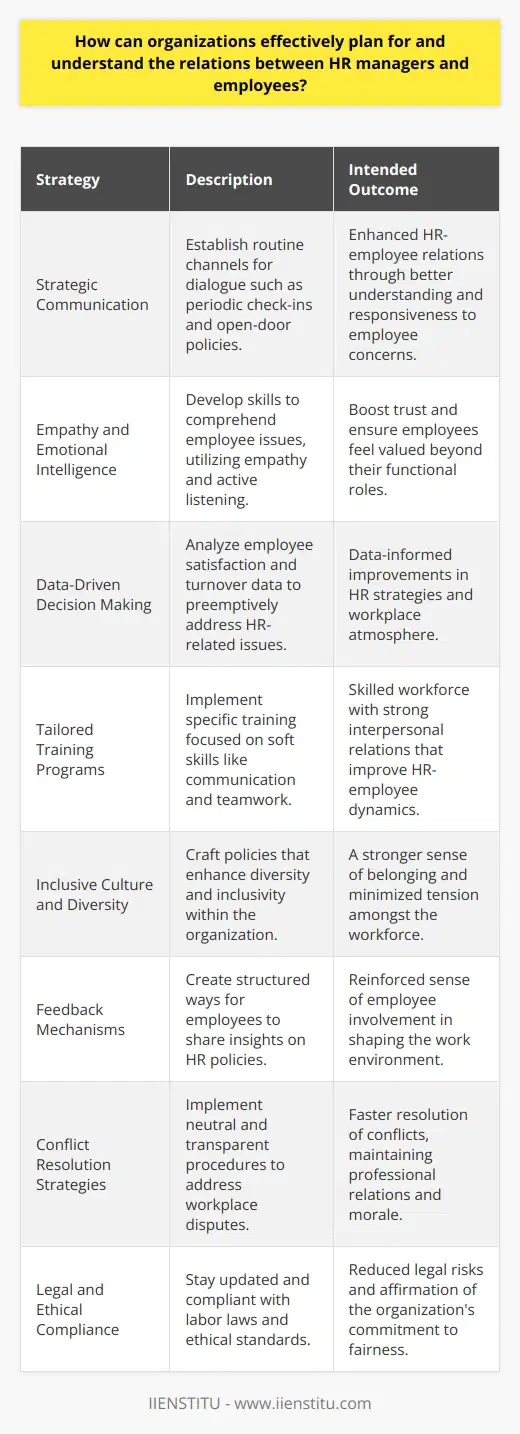
What are some best practices for developing a successful HR model within an organization?
Organizational success is mainly dependent on the business's Human Resources (HR) management model. Managers must therefore consider best management practices to maximize employee engagement, cultivate an equitable work environment, and ensure the long-term sustainability of the organization.
In building a successful HR model, employers must first recognize that the model is much more than a list of rules and regulations. Instead, strategic HR practice involves actively promoting an organization-wide culture and creating an environment that allows employees to thrive. This entails developing and implementing clear HR policies, building trust with present and future employees, and forming solid relationships.
First, when developing an effective HR model, organizations must carefully consider their overall mission and goals and ensure that the HR model reflects these. Next, HR policies should be rooted in the business's core values and communicated to all employees. From there, companies should invest in the training and development of their workforce and create rewards and incentives to motivate their employees.
Second, a successful HR model pays attention to diversity and an inclusive workplace. It is essential to build an equitable HR model that encourages acceptance of different ideas, opinions, and backgrounds. A fair and diverse work environment allows employees to feel valued, improving morale and performance.
Third, a successful HR model is employee-centric. This means understanding and responding to the needs of employees and actively engaging employees to create an open and collaborative culture. Employees should be given opportunities to provide input and discuss corporate goals and objectives. Additionally, employers should ensure constant communication to keep employees informed of changes and updates.
Finally, a successful HR model includes a comprehensive recruitment and retention strategy. Recruitment efforts should focus on finding the right individuals for the job and the organization. Further, employers must invest in developing effective employee onboarding programs that foster a sense of inclusion and support.
By following these best management practices, employers can ensure their HR model effectively creates a positive and productive work environment. Additionally, they can reap long-term benefits such as improved productivity, retention of talent, and an increase in positive morale.

How can organizations use HR to reduce turnover and increase employee engagement and satisfaction?
Human resources can reduce employee turnover and increase employee engagement and satisfaction in a business. To do this, these fundamental strategies should be implemented to create a positive work experience.
First and foremost, providing employees with competitive compensation and benefits is one of the essential strategies to reduce employee turnover and increase employee engagement and satisfaction. This includes competitive salaries, stock options, and bonuses. Additionally, considerable emphasis should be placed on offering employees a comprehensive benefits package that provides access to healthcare, retirement savings plans, and other perks that employees can use to meet their individual needs.
Another approach is to focus on offering employees meaningful work. Organizations should ensure that employees feel valued by providing significant roles and tasks, comprehensive training, and growth opportunities. Further, rewarding employees for high performance through recognition and incentives will motivate them to stay and contribute their best work to the company.
Workplace culture also plays a crucial role in retaining employees and increasing employee satisfaction. Organizations can promote a positive and supportive culture by regularly recognizing employees, providing opportunities for social engagement, and encouraging employee involvement in organizational decisions. Through these activities, employees will feel connected and supported in the workplace, leading to increased job satisfaction and commitment to the organization.
Finally, a successful human resources program should prioritize employee wellbeing. This could include providing flexible work schedules, offering resources to aid work-life integration, and creating an environment that encourages open communication. These activities can help employees feel supported and respected in the workplace, leading to increased job satisfaction and greater employee engagement.
Overall, HR can be a powerful tool for organizations to reduce turnover and increase employee engagement and satisfaction. To do this, organizations should focus on offering competitive compensation and benefits, providing meaningful work, creating a positive workplace culture, and prioritizing employee wellbeing. Organizations can create a motivated, dynamic, and prosperous environment through these strategies.
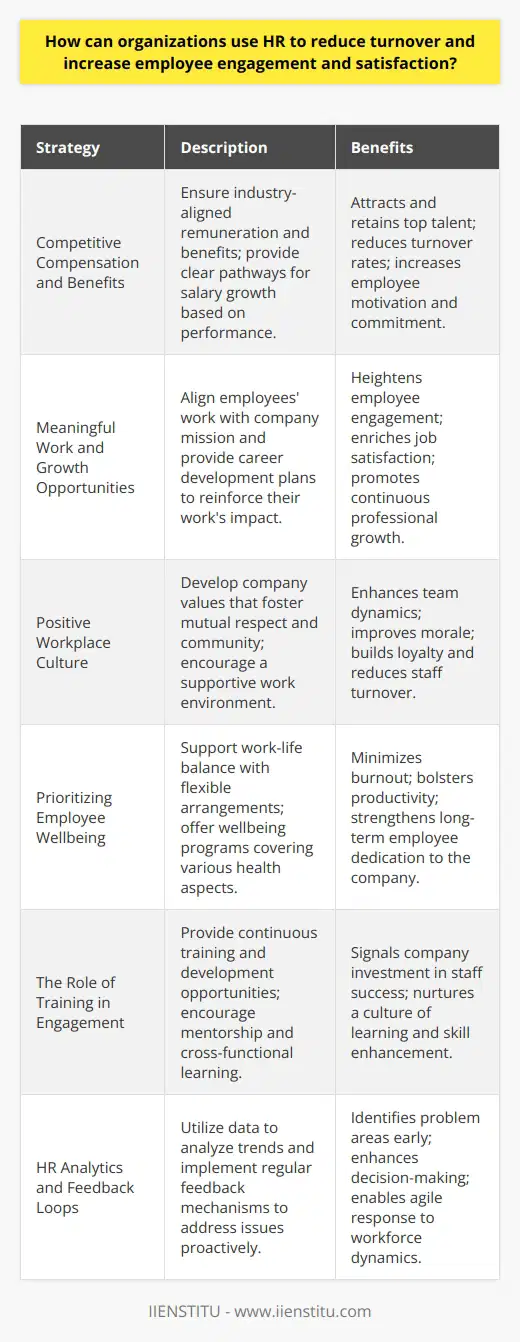
What are the key factors influencing the continuous development and transformation of HR practices?
Factors Contributing to HR Transformation
Organizational Context
One of the key factors influencing the continuous development and transformation of human resources (HR) practices is the organizational context in which HR operates. Organizational structure, size, strategy, culture, and resources significantly impact HR's ability to adapt and drive change, shaping the direction of HR transformation processes.
Technological Advancements
The rapid advancement of technology and automation tools greatly influences HR practices, allowing for better data analysis, workforce planning, and talent management. These advancements enable HR professionals to make more strategic, data-driven decisions and automate time-consuming tasks, thus promoting continuous development and transformation within the field.
Globalization
Globalization has broadened the scope of HR practices, making it necessary for HR professionals to manage diverse workforces, navigate different labor markets, and comply with varying regulations across multiple countries. Globalization has also increased competition for top talent, prompting organizations to expand their skill development and talent acquisition strategies in order to secure qualified candidates.
Demographic Shifts
Changing demographics in the workforce, marked by an aging population, growing diversity, and evolving generational values, require HR practices to adapt and ensure inclusivity, equal opportunity, and employee well-being. These demographic shifts necessitate the transformation of traditional HR practices to accommodate evolving workplace needs and expectations.
Legislative and Regulatory Changes
HR practices are heavily influenced by legislative and regulatory changes that impact employment laws, worker rights, and requirements for compliance. Staying abreast of these changes is crucial for HR professionals in order to proactively address potential issues and adjust practices to maintain legal compliance and minimize organizational risk.
Best Practices and Research
Adopting best practices and leveraging research in the field of HR further drives the continuous development and transformation of HR practices. HR professionals must stay knowledgeable about industry trends and research findings to inform their decision-making, identify areas for improvement, and implement evidence-based strategies to optimize their organization’s human capital management.
In conclusion, the key factors influencing the continuous development and transformation of HR practices include organizational context, technological advancements, globalization, demographic shifts, legislative and regulatory changes, and the adoption of best practices and research findings. These factors shape the future of HR and require professionals to be adaptive, strategic, and informed in order to drive organizational success.

How do advancements in technology and data analytics impact the evolution of HR management strategies?
Impacts of Technological Advancements on HR Management Strategies
Increased Efficiency and Accuracy
Advancements in technology and data analytics have significantly impacted the evolution of HR management strategies through increased efficiency and accuracy. Automated systems allow HR professionals to process large volumes of data quickly, reducing time-consuming administrative tasks and the likelihood of human error.
Data-Driven Decision Making
Human resource management has embraced data analytics, leading to evidence-based decision making. The ability to analyze employee performance, engagement and turnover rates, and other workforce metrics has empowered HR professionals to align strategies with organizational goals and address potential issues proactively.
Enhanced Employee Experience
The use of technology in HR management has enabled the creation of better employee experiences. Digital platforms offer streamlined application processes, virtual onboarding, and continuous professional development opportunities, fostering positive relationships between employees and the organization. In turn, this enhances employee engagement, retention and overall satisfaction.
Customized Learning and Development
Data analytics enables HR teams to design customized learning and development programs based on individual employee needs and preferences. Personalized training fosters skill development, enhances performance, and supports career growth, while contributing to a more flexible and adaptable workforce, meeting future organizational needs.
Improved Talent Acquisition and Retention
The use of technology in HR management has greatly improved talent acquisition and retention strategies. Applicant tracking systems and AI-powered recruitment tools help organizations tap into wider talent pools, identify better candidate matches, and streamline the hiring process. Additionally, data analytics provides insights into factors affecting retention, enabling HR to implement targeted strategies to retain valuable employees.
Conclusion
The integration of technology and data analytics in HR management has revolutionized the way organizations approach human resource strategies. The ability to process extensive data, enhance employee experiences, customize learning opportunities, and improve talent acquisition processes has led to more effective and efficient HR management, contributing to organizational success.

In the context of strategic HR management, what approaches can be utilized to promote employee development and retention across various industries?
Approaches to Employee Development
In the realm of strategic Human Resource (HR) management, fostering employee development and retention is fundamental across various industries. One approach to achieving this goal is providing ample opportunities for skill enhancement and professional growth through training and development programs. These programs can encompass workshops, seminars, and online courses tailored to specific job roles or industries.
Mentoring and Coaching
Furthermore, establishing a mentoring or coaching system can also prove beneficial in promoting employee development. This strategy involves pairing experienced employees with newcomers or those seeking career progression, aids in fostering a supportive learning environment and cultivating the transfer of knowledge and expertise within the organization. By offering guidance and valuable insights, mentors and coaches can contribute to not only individual growth but also strengthen team dynamics.
Regular Performance Evaluations
To efficiently identify areas for improvement and potential opportunities for career advancement, regular performance evaluations are essential. By conducting structured appraisals on a predetermined basis, organizations can assess individual employee contributions, provide constructive feedback, and set attainable targets for future performance. Additionally, performance evaluations facilitate effective communication between management and staff, enabling organizations to address concerns and implement appropriate interventions promptly.
Recognition and Rewards
Recognizing and rewarding employee accomplishments is another crucial aspect in promoting development and retention. By implementing systems that explicitly acknowledge exceptional performance and achievements – such as promotions, bonuses, or even simple public recognition – employers can incentivize employees and cultivate a workplace where hard work and dedication are valued. This positive reinforcement not only boosts employee motivation and satisfaction but also fosters a sense of belonging, which in turn contributes to overall job satisfaction and retention.
Flexible Work Arrangements
Lastly, organizations need to adapt to the growing demand for flexibility in the workplace, as flexible work arrangements can play a significant role in enhancing employee satisfaction and retention. By offering options such as remote work, flexible work hours, and job-sharing, employers can accommodate the diverse needs and preferences of their workforce. This allowance, in turn, can demonstrate the organization's commitment to the work-life balance and well-being of its employees, which would significantly impact retention rates.
In conclusion, strategic HR management should utilize diverse approaches such as offering training and development programs, establishing mentoring and coaching systems, conducting regular performance evaluations, recognizing and rewarding employee achievements, and adopting flexible work arrangements to promote employee development and retention in various industries. By investing in each employee's personal and professional growth, organizations can reap the benefits of a highly skilled, motivated, and loyal workforce.
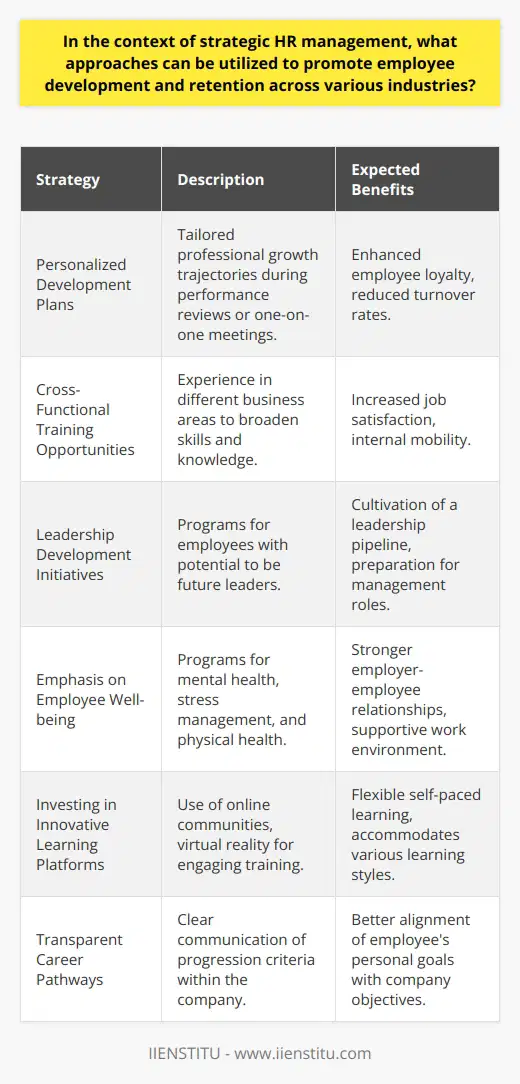
How can HR function be improved by leveraging technology and data analytics in strategic decision-making processes?
Enhancing HR Decision-making with Technology and Data Analytics
Integrating Technology Tools
The improvement of the human resource (HR) function through leveraging technology and data analytics represents a fundamental shift in strategic decision-making processes. By integrating advanced technology tools, HR professionals can streamline operations, enhance communication, and improve efficiency in their daily tasks. These tools aid in the collection, organization, and analysis of employee data, enabling HR managers to make informed decisions relating to recruitment, talent management, and performance evaluation.
Data-Driven Insights
Data analytics plays a crucial role in refining the HR function by providing valuable insights into employee performance, productivity, and satisfaction. By analyzing patterns and trends in this data, HR professionals can identify areas for improvement and make strategic decisions to foster employee engagement and career development. Furthermore, data analytics can support the implementation of equitable and inclusive policies, as it allows HR managers to detect potential biases and discrepancies in areas such as compensation, promotions, and talent acquisition.
Predictive Capabilities
Another benefit of incorporating analytics in the HR function is its predictive capabilities. Predictive analytics utilizes historical data, algorithms, and machine learning techniques to forecast future trends and outcomes. By identifying employees who are at risk of attrition, for example, HR managers can proactively implement retention strategies and minimize turnover costs. Additionally, predictive analytics can help HR managers anticipate skills gaps and talent shortages, enabling them to make strategic decisions to ensure the organization is well-equipped with the necessary human capital for sustained growth and competitiveness.
Automation and Efficiency
Lastly, technology and data analytics can improve the HR function through automation of routine tasks, such as tracking attendance, managing leave requests, or processing payroll. Automating these tasks not only reduces administrative burden but also minimizes human error, ensuring data accuracy and consistency. Consequently, HR professionals can focus on more strategic decision-making tasks, such as organizational development, talent management, and workforce planning.
In conclusion, leveraging technology and data analytics in the HR function can significantly enhance strategic decision-making processes. By integrating advanced tools, utilizing data-driven insights, employing predictive capabilities, and automating routine tasks, HR professionals can optimize their operations, ensure informed decision-making, and effectively address the organization's human capital needs.
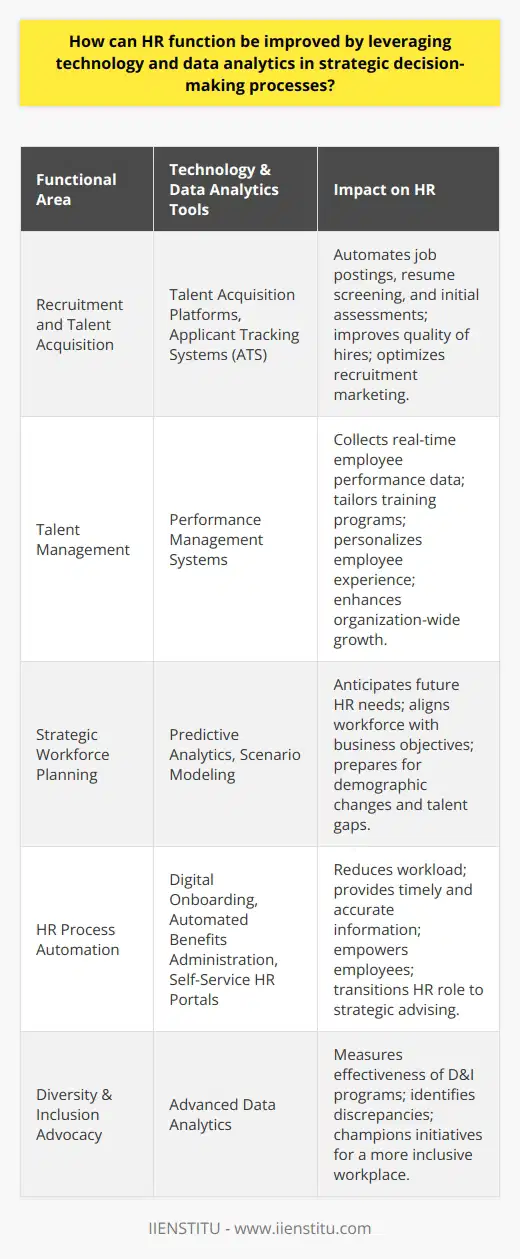
What are the phases of HR transformation and how do they impact overall organizational performance and growth?
Phases of HR Transformation
The process of transforming human resource (HR) management can be divided into four key phases: assessment, planning, implementation, and evaluation. These transformative stages possess a significant impact on an organization's overall performance and growth.
Assessment Phase
During the assessment phase, HR departments analyze their current practices and identify potential areas for improvement. This may involve evaluating employee engagement levels, turnover rates, company culture, and recruitment processes. Additionally, benchmarking against industry best practices can help organizations understand their competitive position and identify areas for further development.
Planning Phase
In the planning phase, HR teams collaborate with organizational leaders to set strategic objectives and priorities for HR transformation. This includes establishing a vision and mission for the HR function, defining new roles and responsibilities, and creating a comprehensive plan for change management. By aligning HR transformation efforts with the organization's strategic goals, the planning phase ensures that HR initiatives will have a positive impact on overall performance.
Implementation Phase
The implementation phase involves the actual execution of the HR transformation plan. This may include revamping talent acquisition strategies, creating new employee engagement initiatives, and adopting new HR technologies to streamline operations. Strong communication and change management are crucial during this phase, as staff members must be educated and encouraged to adapt to new HR systems and practices.
Evaluation Phase
Finally, the evaluation phase involves closely monitoring the success and outcomes of the HR transformation initiatives. HR professionals should assess the results of their efforts by measuring key performance indicators (KPIs) such as employee retention, productivity, and cost savings. These metrics will provide valuable insights to help refine and adjust transformation strategies, ensuring that they continue to deliver long-term value for the organization.
In summary, HR transformation is a continuous process that involves assessment, planning, implementation, and evaluation. Each phase plays a crucial role in shaping the organization's HR practices for improved efficiency, employee satisfaction, and overall performance. By investing in HR transformation, companies can unlock their full potential for growth and success, providing a competitive edge in today's rapidly-evolving business landscape.

How HR functions are evolving in response to changing workforce demographics, globalization, and an increasing emphasis on employee well-being and work-life balance?
Shift Towards Diversity and Inclusion
In recent years, Human Resource (HR) functions have undergone significant transformations to adapt to the changing workforce demographics and globalization. One prominent evolution is the increasing focus on fostering diversity and inclusion in the workplace, as studies have shown that a diverse workforce can lead to greater innovation, creativity, and financial performance. Consequently, organizations are now actively seeking professionals with varied backgrounds, skills and experiences, breaking down traditional barriers and promoting equal opportunities for all.
Global Talent Management
Globalization has brought about the need for organizations to manage talent effectively on a worldwide scale. HR teams are now responsible for ensuring cross-cultural competence, which enables organizations to create a cohesive work environment that embraces diversity. This includes conducting comprehensive personnel assessments, providing multicultural and global leadership training, and establishing global mobility programs to facilitate seamless transitions for employees working across borders.
Promoting Employee Well-Being
There has been a growing awareness of the importance of employee well-being, which has prompted HR teams to introduce programs that support employees' mental, emotional and physical health. These programs often encompass mindfulness and stress management workshops, fitness programs, and access to mental health resources. Employers are also increasingly emphasizing the significance of work-life balance to reduce employee burnout, attrition, and improve overall job satisfaction.
Flexible Working Arrangements
The increasing emphasis on work-life balance has also resulted in the widespread adoption of flexible working arrangements. HR departments are now developing policies that allow employees to work remotely or on a part-time basis, ensuring that organizations can retain top talent, boost productivity, and foster employee satisfaction. This shift in working patterns also necessitates adaptations in performance evaluations, taking into consideration the new work structure and individual circumstances of each employee.
Technology Integration in HR Functions
The advancements in technology have led to the incorporation of HR software applications, which streamline various administrative, communication, and recruitment processes. These tools facilitate more efficient management, collaboration, and reporting while enabling HR professionals to focus on delivering strategic value to the organization. Automation has also played a crucial role in achieving a more data-driven approach in HR decision-making, as it allows for better tracking of employee performance, feedback, and organizational needs.
Overall, the evolution of HR functions in response to the changes in workforce demographics, globalization, and the increasing emphasis on employee well-being and work-life balance has created a more inclusive, supportive, and adaptive workplace that caters to the diverse and ever-changing needs of modern organizations.
